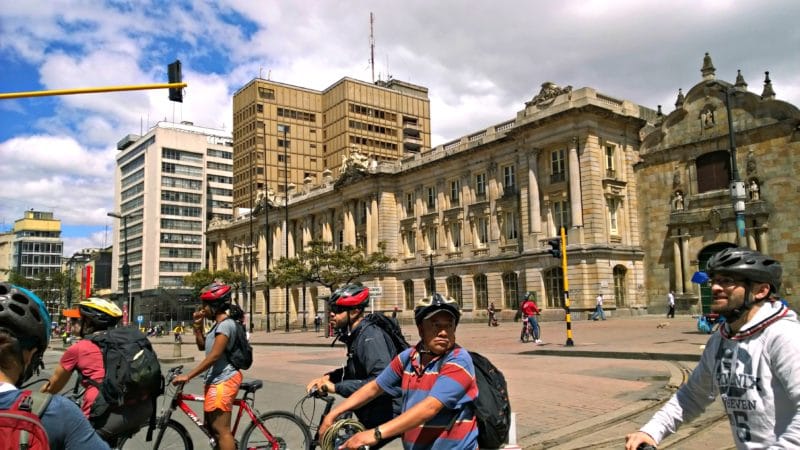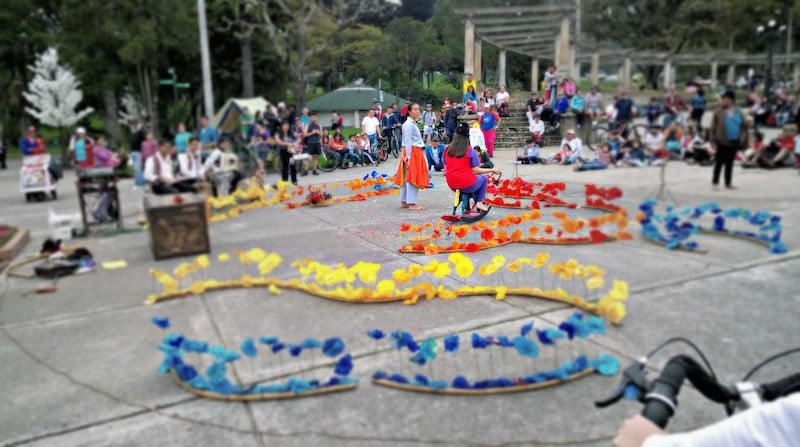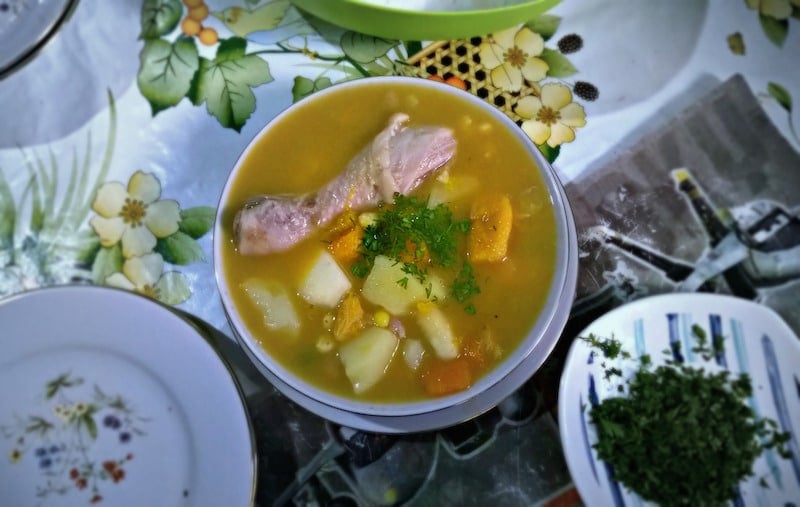Traveling through Cartagena and Medellin, I was told by locals and other travelers that while Bogota had a lot of culture, it was also a place you needed to watch your back. As I only had one full day in the city and wanted to make the most of it — but also wanted to feel safe and not end up in any dodgy neighborhoods alone — I opted for a bike tour.

I’m an avid cyclist, both when I’m traveling and when I’m not. For me, cycling around a city allows you to really feel its pulse. It’s not like a bus tour where you’re looking out at a place and its people from behind glass — similar to a zoo experience — or spending an entire day at an attraction becoming an expert on one facet of the culture. Biking around a city allows you to get a feel for it, to immerse yourself in its sights, sound, smells and colors.
Speaking of colors, Bogota has a lot of them, as it’s one of the world’s best cities for exploring thought-provoking street art. We learned about many of the local artists and what their works stood for, from human rights to peace to prompting people to eat healthier food. My favorite piece of street art was a painting of Pablo Escobar’s hippo eating a rat.
Interestingly, Pablo Escobar is responsible for a growing hippopotamus epidemic that is causing a country-wide crisis, as his exotic animal collection included four hippos that have now inbred into about 60, taking over the countryside where Escobar’s Hacienda Napoles resides. To put the situation’s gravity into perspective, hippos kill more humans than any other animal in Africa. Plus, as Escobar’s hippos are inbred, they tend to be even more aggressive.
But, back to the biking.

Watching an al fresco salsa class during my Bogota bike tour on the Ciclovía
As I opted to do the cycling tour on a holiday, I was able to enjoy Bogota’s Ciclovía (Cycleway), which happens on Sundays and public holidays when certain roads are closed to cars and open to only bikes and pedestrians, with healthy activities taking place. This was a great — albeit hectic — experience. Who knew Colombians loved to cycle so much? Along with the ~30 cyclists on our tour (some of whom weren’t the most skilled bikers), the streets were packed with locals peddling around, not to mention families pushing strollers and couples walking hand in hand and locals taking exercised classes. As someone who values physical fitness, I loved exploring this part of Bogota’s culture.

Cycling through Bogota’s La Merced neighborhood
Not all of the tour was hectic, though. We also cycled through more ambient spaces, such as La Merced, a neighborhood created in the 1930s and 40s with brick Tudor-style houses resembling buildings in London. This shouldn’t be too surprising, as it was built by Londoners in Bogota working for British Petroleum, and helped them feel more at home. Another architectural highlight was riding through La Candelaria, the city’s historic center full of Spanish Colonial, Baroque and art deco architecture and colorful street art. And for some arts and culture, the National Park allowed the group to watch children playing “blind football” and hockey in old fashioned skates, as well as cultural performances like over-the-top clown shows and capoeira.
In the city’s bullfighting area we learned about the controversies surrounding the sport. While Bogota has animal rights laws, there are a few exceptions, bullfighting being one of them. When bullfighting occurs locals will protest, although one positive of the entire situation is bulls that are killed are eaten, so the meat is used. Near the bullring, you’ll see street art protesting bullfighting, much of it destroyed by bullfighters.

Watching an al fresco performance in Bogota’s National Park
Another controversial topic we talked about in depth are the ongoing peace negotiations taking place in Havana, Cuba, between the government and the FARC, Colombia’s largest guerilla group composed of Marxist rebels. The FARC started out in 1964 as a peasant army fighting for the landless, but are now known for violence, killing, kidnapping and terrorizing both political figures and innocent civilians, as well as drug trafficking, stealing land and recruiting child soldiers.
One problem with the peace negotiations is that while the guerrillas want to sign a peace treaty and go into politics, many Colombians believe they deserve long prison stays and should compensate their civilian victims. One story we heard on the tour was about how guerillas hung banners memorializing a fallen guerilla on territory belonging to the NASA indigenous people. When the indigenous people removed the flags, the guerillas killed two of them.
But the corruption and violence doesn’t just fall on the guerillas. One major scandal we learn about is something known as the “False Positives,” which occurred during the presidency of conservative Alvaro Uribe, when current President President Juan Manuel Santos was then defense minster. The military gave military units money and time off for each guerilla they killed. In order to up their profits, soldiers lured young men, including some who were poor or mentally-challenged, with promises of work, then killing them and dressing them up as terrorists to earn bonuses. According to Colombia Reports, 1 in 5 kills are thought to have actually been civilians, a disheartening statistic.
Off our bikes were were also able to experience a number of cultural experiences. One was a stop at the Cafe de la Fonda, where they roast their own coffee beans. After a short narrated tour in English of the production area, the group was brought into the cafe area to order Colombian coffee and cakes and mingle. Once we exited, two youth from a rough Bogota neighborhood impressed with their budding rap skills, as they rhymed about local issues.
Another interactive highlight was exploring the local Paloquemao Market and trying an array of exotic fruits (complimentary!). Soursop, dragonfruit, avocado, prickly pear, chirimoya, mangostine and maracuya were just a few of the many fruits we got to try. We also were able to peruse colorful flowers, a cultural experience as Colombia is the world’s second largest exporter of flowers after Holland.
My personal favorite stop of the tour was getting a chance to play Colombia’s national sport, Tejo. We entered a large musty room where local men drank Aguila beers and threw giant stones into mud pits. The object of the game is to hit small targets full of gun powder, which causes an extremely loud explosive sound that will literally make your ears ring if you’re too close. While it’s not a sport I plan to take up back in New York, it was fun to try it for myself.

Trying my hand at Tejo, Colombia’s national sport. Photo courtesy of Mike from Bogota Bike Tours.
Woven into the tour were also interesting anecdotes and tidbits enlightening the group about local culture. While cycling through the Red Light District we learned about how prostitution is legal, although the neighborhood we road through was the only place where prostitute’s could showcase their bodies out on the streets. Moreover, riding through Bogota’s “Abortion District” allowed us to learn about the city’s stance on abortion. While its technically only legal in four extreme circumstances — rape, incest, when the mother’s life is in danger or if the child will have severe abnormalities — there are many cases of supposed doctors performing these procedures on any woman who wants it. We heard one story about a woman who began hemorrhaging during an abortion, but because it was an illegal procedure the doctor refused to call for help and the woman died.

Mike, the bike tour guide, regaling us with stories of Bogota culture in front of the National Museum
While many of the anecdotes are told above and on the tour are on the darker side, the mood of the tour isn’t sadness, but enlightenment. The truth is, corruption, poverty and crime are problems that are very real in Colombia. Learning about local issues and hearing the stories that surround them allowed our tour group to further understand the psych of the country, its problems, its attempts toward resolution and its spirit.
I’d also like to say that while Colombia is a country where many problems exist, it is still a place that tourists can safely visit.

Sancocho, a special Colombian soup
Delicious Addition
Bogota Bike Tours can set up a cooking class for you after your bike tour. Just make sure to reserve ahead of time. You’ll have the option to make one of Colombia’s quintessential dishes (my friends and I made Sancocho, a chicken and vegetable soup served only on Sundays and during festivals). The class is only in Spanish, although you’ll be fine as long as you have a basic understanding of the language. I’m not fluent and thoroughly enjoyed the class. The cost for a group of four people was 25,000 COP each + 5,000 COP for ingredients (about $15 each total).
Have you explored Bogota, by bike or on foot? Please share your experiences in the comments below.
Featured image courtesy of Mike from Bogota Bike Tours, edited by me — unless otherwise noted, all other photos are courtesy of Jessica Festa.

Jessica Festa is the editor of the travel sites Jessie on a Journey (http://jessieonajourney.com) and Epicure & Culture (http://epicureandculture.com). Along with blogging at We Blog The World, her byline has appeared in publications like Huffington Post, Gadling, Fodor’s, Travel + Escape, Matador, Viator, The Culture-Ist and many others. After getting her BA/MA in Communication from the State University of New York at Albany, she realized she wasn’t really to stop backpacking and made travel her full time job. Some of her most memorable experiences include studying abroad in Sydney, teaching English in Thailand, doing orphanage work in Ghana, hiking her way through South America and traveling solo through Europe. She has a passion for backpacking, adventure, hiking, wine and getting off the beaten path.








